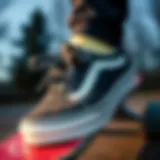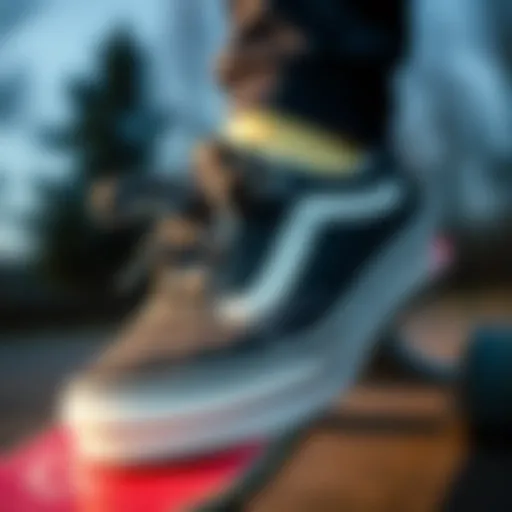Understanding Power Grip Tape for Skateboarding
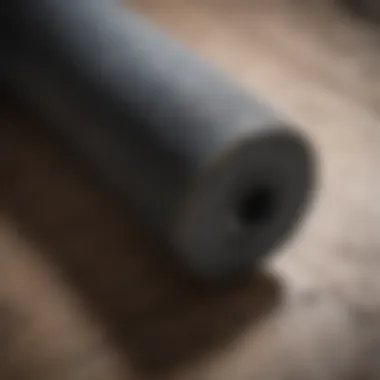

Intro
When diving into the world of skateboarding, it's not merely the board that captures the attention of enthusiasts; the elements that contribute to a good ride play an invaluable role as well. Among those components, power grip tape stands out as a significant player. For both seasoned skaters and newcomers alike, understanding grip tape’s function, variety, and application methods can enhance their skating experience tremendously.
Power grip tape is not your average adhesive strip; it’s crafted from materials that provide superior traction, stability, and durability. In a sport that demands precision and agility, having the right grip tape can make a world of difference, enabling skaters to execute moves with greater ease and confidence.
The conversation doesn’t end there. This article serves as a roadmap through the intricacies of grip tape, covering everything from its composition to its proper application techniques. We will sift through the latest advancements in technology behind grip tape, clarify common misconceptions, and offer care tips to ensure longevity. With this guide, every skater, from the timid beginner to the expert maneuverer, can find the knowledge they need to choose and maintain their power grip tape effectively.
Skills Development
Understanding the art of skateboarding shouldn’t just focus on tricks; it must also factor in how grip tape impacts skills and abilities. A firm understanding of how to utilize grip tape can unlock new potentials for all skaters.
Basic Tricks and Techniques
For beginners, learning fundamental tricks is the first step in skateboarding. The grip underfoot becomes a crucial element in gains confidence while practicing. Simple actions such as ollies or pop shuvits rely heavily on a skater’s ability to feel comfortable and secure on their board. The right tape can prevent slipping, allowing for better weight distribution and control during these movements.
When starting out, consider the following:
- Choosing the Right Grip Tape: A rougher texture often provides more grip, which is beneficial for beginners.
- Correct Application: Smooth out bubbles when applying tape to get a solid base.
- Foot Placement: Familiarize yourself with how grip tape feels underfoot, as it can affect the stability of basic maneuvers.
Advanced Maneuvers and Tips
As skaters progress, their focus shifts to more intricate maneuvers—think flips, grinds, and slides. These tricks demand not only technical skill but also a high degree of grip integrity. Advanced skaters often require different types of grip tape according to specific styles or personal preferences.
- Experiment with Thickness: Thicker tapes often provide more cushioning, which can help absorb shocks during landings.
- Customize Texture: Some skaters prefer a smoother gradient for certain tricks where they may need less contact.
- Maintenance Matters: Regularly inspect your grip tape for wear and tear. Ensuring it is clean can enhance longevity and performance.
"A good grip tape feels like an extension of your board; it knows your moves before you even make them."
Skateboarding is an individual journey, and harnessing the right grip with the right tape allows for unique expressions of style and technique. This deep dive into skills development highlights how grip tape, often overlooked, directly correlates to your level of expertise and enjoyment in skateboarding.
Preface to Power Grip Tape
In the skateboarding world, power grip tape is more than just an accessory; it's a fundamental component that can significantly impact a skater's performance and safety. For beginners and seasoned skaters alike, understanding this aspect can elevate the riding experience to new heights.
Power grip tape serves a dual purpose: it ensures that a skateboarder maintains control over their board while also contributing to their overall safety during rides. Imagine carving through a park or mastering tricks at a skate spot; the last thing one wants is to lose grip and tumble over. Good grip tape acts like a trusty partner in crime, providing that essential stickiness underfoot on the board, allowing for confident movements and better execution of tricks.
Definition and Purpose
So, what exactly is power grip tape? In simple terms, it's a textured adhesive tape applied to the surface of a skateboard deck. This tape creates friction between the rubber soles of the skater's shoes and the skateboard, significantly enhancing grip. Think of it this way: just as a good pair of tires on a car provides stability and control while driving, power grip tape ensures that skaters have a solid footing to execute maneuvers reliably.
The purpose here goes beyond just securing the skater's feet to the board; it is about building confidence. When skaters know that their feet won't slip unexpectedly, they are more likely to push their limits, try new tricks, and enjoy the thrill that skateboarding offers. It's safe to say that learning the nuances of power grip tape can lead to improved skills and a deeper appreciation for the sport.
Moreover, investing in quality grip tape can save skaters from potential injuries caused by slips or falls. Having the right amount of grip at the right moment can mean the difference between landing a trick flawlessly or struggling to stay upright.
In summary, power grip tape is critical not just for the mechanics of a skateboard but also for the psychological aspect of skating. Understanding its definition and purpose can enhance a skater's knowledge and competence, making it a crucial topic in this article.
The Composition of Power Grip Tape
The composition of power grip tape is pivotal in understanding its performance and suitability for skateboarders. It’s not just about sticking it on the deck; the materials and properties infused in the tape directly influence how a rider connects with their board, affects stability, and ultimately can shape the skateboarding experience itself. Knowing what goes into power grip tape helps skateboarders make informed choices, ensuring they pick a product that matches their specific needs and styles.
Materials Used
When discussing the materials used in power grip tape, one must consider various components that contribute to both functionality and longevity. The main materials often include:
- Silica Granules: These provide the traction needed for effective grip. The size and texture of the granules can differ, allowing each tape to cater to different riding styles and preferences.
- PVC or Polyethylene Film: This forms the base layer of the tape, ensuring durability and resistance against wear and tear.
- Backed with cushioning foam (though not common in all types): Some tapes utilize a small layer of foam for a softer touch, which can help when doing tricks and landing jumps.
- Protective Coatings: These can be added to enhance the tape’s resistance to moisture, dirt, and other elements that could deteriorate performance.
In particular for skaters, durability and grip are critical. If the tape wears down quickly, it can lead to slips that could result in falls and injuries. Choosing a high-quality grip tape ensures that a skater can focus on perfecting their skills instead of worrying about their footing.
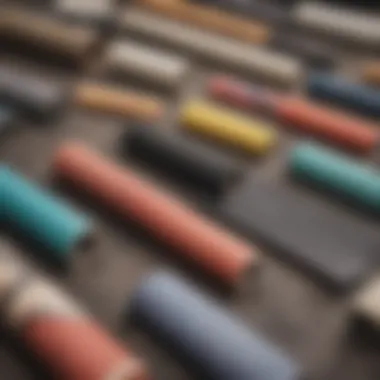

Adhesive Properties
The adhesive used in power grip tape is another vital component that deserves attention. It must be strong enough to endure the repeated impacts and stresses during skating while allowing for a reliable bond with the deck. Here are some key aspects:
- Strength and Longevity: A quality adhesive can withstand the force of tricks and heavy usage without peeling or losing grip. A tape with weak adhesive may begin to lift from the edges, becoming a hazard for skateboarders.
- Temperature Resistance: It’s important that the adhesive remains effective under various temperatures. Skateboards often face heat from direct sunlight or cold from winter rides, and the adhesive should ensure performance regardless of conditions.
- Easy Application: Additionally, some adhesives allow for repositioning during the application process without losing effectiveness. This can be beneficial for those who are not particularly skilled at applying grip tape.
The right balance of materials and adhesives helps prevent accidents, making every ride safer and more enjoyable.
By focusing on these specific elements in the composition of power grip tape, skateboarders can fully appreciate what sets apart the different options available on the market. From newbie riders learning the ropes to seasoned skaters refining their tricks, understanding these components will ensure everyone finds the ideal grip tape to suit their individual needs.
Benefits of Using Power Grip Tape
When it comes to skateboarding, having control over your board is non-negotiable. Power grip tape serves as the connecting link between the skater and the skateboard, providing a myriad of benefits that elevate not just performance but also the overall experience of riding. This isn’t just a matter of aesthetics; it’s about safety, flexibility, and durability.
Improved Grip and Control
One of the key advantages of using power grip tape is the improved grip it offers. Different skateboarding styles often require varying levels of control, whether you’re performing tricks or cruising through the streets. The enhanced grip helps skaters maintain their footing, reducing the chance of slipping off the board during intense maneuvers. This allows for more precise movements and better trick execution.
- Tactile Surface: The textured surface of power grip tape creates friction between the skateboarder’s shoes and the board, allowing for secure foot placement. This tactile grip transforms a skater's ability to push off the ground or shift weight when landing tricks.
- Customization of Feel: Some skateboarders prefer different grip levels, and power grip tape is available in varied textures. The choice between a rough surface for extreme grip or a smoother option for casual rides can tailor the experience to the individual’s needs.
Enhanced Safety and Stability
Safety is always at the forefront when it comes to skateboarding. Power grip tape plays a vital role in enhancing stability while riding. As skaters take on various terrains, the risk of losing balance spikes. That’s where a high-quality grip tape comes into play.
- Reduced Slippage: A solid grip reduces the chances of accidental slips, which can lead to falls or injuries. This feature is particularly crucial when skating in wet conditions or on uneven surfaces.
- Confidence Building: Knowing that they won’t easily lose grip allows skaters to commit more fully to their moves. This confidence enables them to push their limits, explore new tricks, and enjoy a more exhilarating ride.
"Security on your board transforms your skating experience. The right grip tape doesn’t just keep you locked in; it empowers you to explore your limits."
Durability Factors
Power grip tape isn’t just about grip; its durability is a game changer. This product is designed to withstand the rigors of frequent skateboarding sessions—whether in the skate park or on the streets.
- Long-lasting Performance: The materials used in craft power grip tape are built to last. This means skaters can depend on consistent performance without frequent replacements. A durable grip tape shields against wear and tear caused by weather, friction, and general use.
- Cost-effectiveness: Investing in high-quality grip tape might seem like an initial expense, but the longevity can yield significant savings over time. Skaters won’t have to constantly replace worn-out tape, allowing them to devote more resources to other aspects of their skating gear.
Application Techniques for Power Grip Tape
Applying power grip tape correctly is crucial for ensuring optimal performance and safety on a skateboard. When it comes to sticking that tape on, there’s more than meets the eye. Whether you’re a newbie skater or someone who’s been boarding for years, understanding the proper techniques can make all the difference. This section will not only guide through the steps but also highlight the importance of preparation and careful application.
Preparation of the Skateboard Deck
Before diving into the actual application of power grip tape, a little preparation goes a long way. First off, make sure that the skateboard deck is clean and free from any debris or old tape residue. Dirt can be a slippery devil, diminishing the adhesive's grip on your board.
Start by using a mild cleaner or rubbing alcohol to wipe down the surface. Using a soft cloth or paper towel is best to not scratch the surface. Don’t rush through this—patience pays off here. If the deck is rough or has any imperfections, sand these areas lightly to create a smooth surface for the tape to adhere to. Also, inspecting the edges for any chips or splinters is vital as these can interfere with both grip and safety, potentially leading to costly falls.
Step-by-Step Application Process
Once your deck is squeaky clean and prepped, it’s time to get that grip tape on. Here’s a breakdown of the steps:
- Cutting the Tape: If your grip tape isn’t pre-cut, use a utility knife to cut it to the exact dimensions of your skateboard deck. Ideally, it should be slightly larger than the top of the deck—this allows for easier overlap.
- Peeling the Backing: Carefully peel off the backing of the grip tape to expose the adhesive side. Be mindful not to touch this side, as oils from your fingers can reduce its stickiness.
- Aligning the Tape: Start positioning the tape at one end of the skateboard. Gently lower it onto the deck, ensuring it aligns perfectly without twisting or wrinkling.
- Smooth it Out: As you lay the tape down, use a roller or your hand to press down from the center out towards the edges. This helps to eliminate air bubbles, which can weaken the grip.
- Trimming Excess: Once it’s all stuck down, use your utility knife to trim the edges, making sure you’re cutting accurately along the board’s sides.
- Final Pressing: Give it another good press to ensure there are no gaps or air bubbles left.
Following these steps can help ensure a snug and secure fit that will stand up to the rigors of street skating or park sessions.
Common Mistakes to Avoid
Mistakes happen, especially when trying something new. Here are some blunders that skaters commonly make and how to sidestep them:
- Skipping Cleanliness: Not cleaning the deck properly before applying can lead to premature peeling.
- Overextending Tape: Stretching the tape too much can cause it to lift over time. Remember, grip tape should lay flat.
- Ignoring Bubbles: Leaving air bubbles trapped under the tape can create weak spots. Always smooth them out as you apply.
- Wrong Tools: Using dull knives or incorrect tools can create messy edges and improper trimming.
Avoid these pitfalls, and you’ll find the application process smoother and the result far more effective. It can mean the difference between a solid board and one that feels like it's slipping out from under your feet.
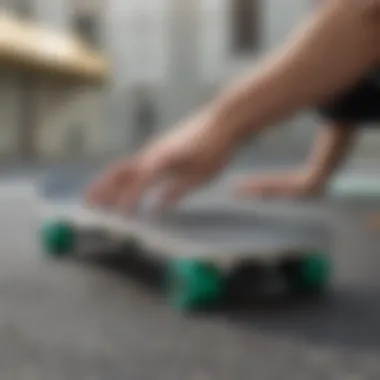

Types of Power Grip Tape
Understanding the various types of power grip tape is essential for any skateboarder aiming to enhance their riding experience. Each kind of grip tape serves a unique purpose and can significantly affect the performance and comfort of the ride. Knowing what each type offers helps in making an informed decision based on personal preferences and skating style.
Standard Grip Tapes
Standard grip tapes are often the go-to choice for many skaters. Made from a combination of silicone carbide and a sturdy adhesive, these tapes offer a rough texture that provides excellent traction. The feel underfoot is a reliable option, ensuring that your feet stay firmly planted on the board during tricks and turns.
- Durability: Most standard grip tapes have a lengthy lifespan, maintaining their grip even under frequent use.
- Variety: They come in numerous colors and grain sizes, catering to different aesthetics and preferences
- Budget-Friendly: Generally, standard grip tapes are more affordable than specialized alternatives, making them accessible for skate rookies and seasoned pros alike.
These tapes are fitting for everyday skating, whether you're performing tricks at a skate park or cruising down for some fresh air. Just keep in mind that they may not be ideal for wet conditions since moisture can diminish grip performance.
Anti-Slip and Performance Tapes
When skateboarding performance is paramount, anti-slip and performance tapes enter the arena. Designed with advanced materials and technology, these tapes specifically aim to enhance grip levels without compromising on feel. They often utilize textures or patterns that elevate friction against your shoes.
- Enhanced Grip: These tapes feature specialized surface designs to prevent slipping during high-action moments, especially for performing tricks like ollies and kickflips.
- Weather Resistant: Many anti-slip tapes are resistant to water and dirt, which keeps their performance up when conditions get tough.
- Shock Absorption: Some of these tapes even include cushioning layers that help absorb impact during jumps or falls, adding an extra layer of protection for the rider.
Skaters often opt for this type when they’re competing or pushing the limits of their abilities, as the benefits can translate directly into improved confidence and control on the board.
Custom Designs and Graphics
Custom grip tapes allow for a personal touch, combining functionality with art. These tapes are often produced using high-quality graphics printed directly onto the tape. This not only adds a dash of style to your board but also provides a canvas for self-expression.
- Express Yourself: Whether you favor a wild pattern, a favorite band logo, or custom artwork, the options are virtually limitless.
- Unique Traction Patterns: Some custom tapes feature unique grip mechanisms, which can sometimes provide an edge in performance.
- Community Engagement: Many skaters enjoy showcasing their individuality, and using custom designs has become a popular way to connect within the skating community.
While these tapes might not always feature the same level of grip as the anti-slip varieties, they compensate with personality and flair.
"Finding the right grip tape is as personal as selecting a skateboard itself—it's about fit, feel, and finesse."
Evaluating Grip Performance
Evaluating grip performance is a vital aspect that skateboarders must not skim over. The way a skate deck connects with the feet can make all the difference between a blazing ride or a nasty spill. It isn’t just about having something sticky on the board; it’s about understanding how that grip affects control, safety, and overall skater confidence when hitting the streets or skate parks. This section delves into the various elements that play a role in grip performance, outlining its importance in achieving not just better tricks but also in fostering a culture of safety among skaters.
Factors Influencing Grip Levels
Several factors influence how effectively grip tape performs under different skate conditions. Here are some key elements to consider:
- Texture Type: The surface texture of the grip tape contributes heavily to the grip levels. Tapes with a rougher texture generally offer better grip, allowing skaters to maintain control during tricks. Conversely, smoother tapes may slide a bit too much, especially in wet conditions.
- Weather Conditions: Rain or humidity can affect the performance of grip tape. Wet surfaces can make a board much slicker, reducing the effectiveness of grip tape. Likewise, extreme heat can cause adhesives to break down, lowering grip stability.
- Footwear: The sole of the skater's shoe interacts with the grip tape surface. Shoes with a more rubbery sole material often provide better traction than those made from harder materials.
- Wear and Tear: Over time, grip tape can become worn-down and lose its effectiveness. Regular inspection of the grip to check for any bald patches or peeling edges is important.
- Weight Distribution: Where the weight is concentrated during tricks can also play a role. Heavier landings may compress the tape and slightly affect grip.
Understanding these factors helps skaters tweak their setups in order to maximize their grip performance.
Testing Grip Tape Effectiveness
Testing the effectiveness of grip tape is crucial for skaters who wish to avoid unpleasant surprises during rides. Here are some methods to evaluate the grip tape your board has:
- Simple Slip Test: The most straightforward way to test grip is to place your foot on the tape and apply pressure. If it feels slippery or your foot shifts more than expected, it may need replacing.
- Braking Test: In a safe area, perform controlled stops by dragging your foot along the grip. If you can’t rely on the grip for quick stops, it’s time to rethink your tape.
- Comparison Test: If you have access to different types of grip tapes, it’s beneficial to lay them side by side and try them out. A direct comparison while performing the same tricks can help in choosing the best fit.
- Visual Inspection: Keep an eye on the appearance of your tape. Cracks, tears, or bald spots might mean the grip has deteriorated, which will make riding riskier.
"A solid grip offers a skater the confidence to push boundaries and expand their skill set. It is an unsung hero of every successful trick."
In summary, evaluating grip performance is not merely an afterthought; it is intrinsic to the spirit of skateboarding itself. Taking an active interest in how your grip tape performs relative to the factors affecting it, and regularly testing its effectiveness can lead to both improved performance and enhanced safety on the board.
Care and Maintenance of Power Grip Tape
When it comes to skateboarding, the grip tape on your board doesn’t just play a vital role in your control and stability; it also needs proper care to maintain its effectiveness over time. Just like a chef looks after their knives or a musician tends to their instruments, a skater must pay attention to their grip tape. Regular care and maintenance can enhance the lifespan of the grip tape, ensuring consistent performance and safety.
Cleaning Techniques
Keeping your power grip tape clean is essential. Dust, dirt, and debris can accumulate over time, affecting grip quality. Here’s how to keep your grip tape in tip-top shape:
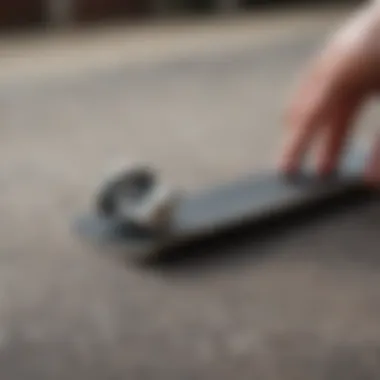

- Brush it Off: Using a stiff-bristled brush, gently scrub the surface of the tape. This will help remove any loose dirt or particles that have settled in. Make sure to do this regularly, especially after a skate session in dirty conditions.
- Sticky Solutions: For more stubborn grime, you might want to use some tape maintenance products. Grip Clean is one example that many skaters swear by. Spray it on, let it sit for a bit, and then wipe it off with a clean cloth.
- Avoid Water: While it might be tempting to wash the grip tape with water, it’s best to steer clear of this. Water can weaken the adhesive bond and lead to peeling over time. If necessary, use a damp cloth, but ensure that it’s not soaking wet.
Remember, a clean grip tape allows for better traction, which directly impacts your riding experience.
Extending the Lifespan
To make sure your grip tape serves you well for an extended period, consider these easy tips:
- Limit Exposure to Elements: Try not to leave your board out in direct sunlight or rain for extended periods. The weather can degrade the adhesive and the texture of the tape.
- Correct Footwear: Wearing appropriate shoes while skating can also contribute to the tape’s longevity. Shoes with worn-out soles can contribute to faster wear and tear on the grip.
- Mind Your Tricks: Some tricks, especially those that involve sliding, can wear down grip tape quicker. Learning to land properly and utilizing the tail of your board effectively can help protect your grip.
- Regular Inspections: Every now and then, take a close look at your grip tape. Look for signs of bubbling, peeling, or excessive wear. Addressing issues early can save you trouble in the long run.
"Investing a little time in the maintenance of your grip tape not only keeps your board safe but also enhances your overall skating experience."
With these practices in mind, you can maintain your power grip tape better and ensure that it serves you well for countless runs.
Common Misconceptions about Power Grip Tape
When it comes to skateboarding, there’s a sea of information swirling around, and power grip tape is no exception. Misunderstandings about its function, effectiveness, and proper usage are commonplace among skaters, both fresh-faced newcomers and seasoned veterans alike. Clarifying these misconceptions is crucial not just for improving skateboarding performance but also for ensuring safety while riding.
One of the core benefits of addressing these myths lies in the potential to elevate the overall experience for skaters. A better understanding of how power grip tape works—and what it can and cannot do—empowers skaters to make informed decisions that will enhance their grip, performance, and safety on their boards.
Myths vs. Reality
Let’s peel back the layers of myth surrounding power grip tape and look at some of the more prevalent misconceptions held within the skateboard community.
- "All Grip Tapes Are the Same"
This is one of the biggest misconceptions out there. In reality, power grip tape varies tremendously in terms of texture, stickiness, and durability. A tape designed for tricks may have a different texture compared to one aimed at casual cruising, so choosing the right one is essential. - "More Grip Equals Better Performance"
Not so fast. While a more textured surface can improve grip, too much roughness can hinder foot movement and make it harder to adjust positions mid-trick. Balance is key here. - "Power Grip Tape Is Only For Advanced Skaters"
This couldn’t be further from the truth. Grip tape is a fundamental element for skaters of all levels. Beginners can benefit from improved grip and confidence, while experienced riders will rely on its performance in complex tricks. - "Once Applied, Grip Tape is Forever"
Incorrect. Grip tape wears down, just like any other material. Regular wear can depend on the type of terrain skated, so periodic checks and replacements are essential to maintain that all-important grip.
"Care for your grip tape as you would your skateboard; maintenance ensures longevity and performance."
By busting these myths, skaters can approach the choice and maintenance of power grip tape in a more informed manner. Additionally, understanding the realities surrounding these misconceptions not only enhances individual performance on the board but also contributes to a more knowledgeable skateboarding community.
Power Grip Tape Innovations
The world of skateboarding is not just about tricks and flips; it's also about the gear that skaters rely on. One such gear that has seen significant advancements is power grip tape. In recent years, innovations in power grip tape have become increasingly vital for enhancing performance and safety on the board. These innovations focus on improving the materials used, optimizing grip efficiency, and designing tapes tailored for various skateboarding styles. This section will delve into the emerging technologies and future trends that are shaping power grip tape.
Emerging Technologies
With technology evolving at a swift pace, power grip tapes are also experiencing a metamorphosis. New material science has sparked the development of grip tapes that provide better adhesion while also maintaining flexibility. Two significant breakthroughs in the field include:
- Nano-coating technologies: These treatments on grip tape surfaces can enhance durability and weather resistance. Tapes with such coatings are better equipped to withstand the degradation caused by elements like moisture, grime, and UV exposure.
- Smart grip tapes: An intriguing aspect of innovation is the introduction of smart grip tapes, which can adapt their properties based on conditions or user preferences. For example, some modern tapes are designed to change their texture depending on humidity or temperature, offering skaters an always-optimal grip.
This focus on technological enhancements not only improves the performance of grip tapes but also bolsters confidence for skaters who want to push their limits.
Future Trends in Grip Tape Design
As the skateboard community continues to grow, the demands for more customized solutions increase. The future of power grip tape design promises several interesting trends that aim to cater to diverse skateboard styles, rider levels, and individual preferences. These trends include:
- Eco-friendly materials: There's a noticeable shift toward sustainability. Manufacturers are exploring biodegradable materials and recycling options for grip tapes. The aim is to reduce the environmental impact while maintaining high standards of performance.
- Custom graphics and personalization: Aimed at self-expression, future grip tapes are likely to offer more room for personalization. Options may include customizable colors, designs, and textures. Skaters could showcase their identity not just by their tricks but by the grip tape they choose.
- Modular grip tape systems: The idea of interchangeable grip tape sections is gaining traction. These systems allow skaters to optimize their board for specific conditions or transitions. Tailoring the grip to fit not just personal preferences but also style variations can be a game changer.
In wrapping up this section, it’s clear that innovations in power grip tape are transforming skateboarding experiences. Not only do they enhance grip performance and safety, but they also open the door for creativity and personalization in the skateboarding world. By keeping an eye on these trends, skaters can make informed choices that resonate with their individual styles and performance needs.
Epilogue
In the world of skateboarding, power grip tape holds immense importance. It is more than just a sheet attached to a skateboard; it is integral for balance, control, and safety while performing tricks. This final section emphasizes vital elements of grip tape that skaters, coaches, and even parents should be aware of.
Recap of Key Points
To sum up our exploration:
- Materials and Composition: The effectiveness of grip tape is tied to its material make-up. High-quality grip tapes prioritize durability and reliable adhesive properties.
- Application Techniques: Learning the proper way to apply grip tape can prevent early wear and tear. Knowing how to prepare the skateboard deck is just as crucial to maximizing the tape's adherence.
- Types of Grip Tape: Not all grip tapes are the same. From standard options to those boasting anti-slip features or custom graphics, understanding these different types can help choose the right one for personal preferences and skill levels.
- Care and Maintenance: To get the most out of grip tape, simple cleaning techniques and awareness of wear indicators can greatly enhance longevity.
Final Thoughts and Recommendations
The skateboard journey is unique for everyone—infusing personal style while ensuring safety is paramount. When selecting power grip tape, consider what aligns with your skating style and needs. Whether you’re a beginner needing more control or an experienced skater keen on adding flair with custom designs, there’s a grip tape tailored for you. Invest time in understanding the nuances of grip tape, as this can dramatically improve performance and boost confidence on the board.
Always prioritize safety and choose high-quality grip tape that supports your skating endeavors.




